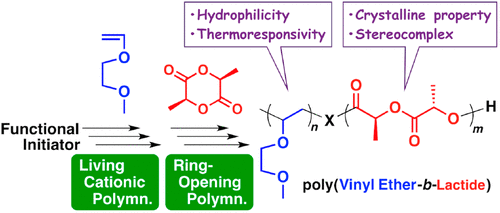当前位置:
X-MOL 学术
›
Macromolecules
›
论文详情
Our official English website, www.x-mol.net, welcomes your feedback! (Note: you will need to create a separate account there.)
Precision Synthesis of Polylactide-Based Thermoresponsive Block Copolymers via Successive Living Cationic Polymerization of Vinyl Ether and Ring-Opening Polymerization of Lactide
Macromolecules ( IF 5.5 ) Pub Date : 2018-01-19 00:00:00 , DOI: 10.1021/acs.macromol.7b02329 Yukiko Seki 1 , Arihiro Kanazawa 1 , Shokyoku Kanaoka 1 , Tomoko Fujiwara 2 , Sadahito Aoshima 1
Macromolecules ( IF 5.5 ) Pub Date : 2018-01-19 00:00:00 , DOI: 10.1021/acs.macromol.7b02329 Yukiko Seki 1 , Arihiro Kanazawa 1 , Shokyoku Kanaoka 1 , Tomoko Fujiwara 2 , Sadahito Aoshima 1
Affiliation

|
A new class of polylactide (PLA)-based block copolymers with thermoresponsive poly(vinyl ether) [poly(VE)] were precisely synthesized via successive living cationic polymerization of VE and ring-opening polymerization of lactide (LA). The synthetic route starts with precise end-functionalization of poly(VE) by living cationic polymerization to produce a macroinitiator having a hydroxy group at the α- and/or ω-end for ring-opening polymerization of LA. End-functionalized polymers of 2-methoxyethyl VE (MOVE) with highly controlled structures were obtained by either an initiation or a termination method under optimized conditions. Subsequent ring-opening polymerization of LA from the hydroxy group of the macroinitiator yielded block copolymers with well-defined structures. The obtained block copolymers were demonstrated to exhibit a thermoresponsive solubility transition in water; this transition was induced by the thermosensitivity of the poly(MOVE) segments. The transition between micelle-like aggregates and phase separation was reversible with a shorter PLA chain, whereas irreversible precipitation was observed with a longer PLA segment. The permanent precipitation upon heating is most likely attributable to crystalline formation of the longer PLA segments. The solution and bulk properties of the block copolymers with enantiomeric PLA were also governed by stereocomplex formation between poly(l-lactide) (PLLA) and poly(d-lactide) (PDLA) segments.
中文翻译:

通过乙烯基醚的连续活性阳离子聚合和丙交酯的开环聚合精确合成基于聚丙交酯的热敏嵌段共聚物
通过连续的VE活性阳离子聚合反应和丙交酯(LA)的开环聚合反应,精确合成了一种新型的基于聚丙交酯(PLA)的具有热敏性聚(乙烯基醚)[poly(VE)]的嵌段共聚物。合成路线开始于通过活性阳离子聚合反应对聚(VE)进行精确的末端官能化,以产生在α-和/或ω-末端具有羟基的大分子引发剂,用于LA的开环聚合。通过引发或终止方法在优化条件下获得具有高度受控结构的2-甲氧基乙基VE(MOVE)的末端官能化聚合物。随后由大分子引发剂的羟基使LA开环聚合,得到具有明确结构的嵌段共聚物。所获得的嵌段共聚物被证明在水中表现出热响应性的溶解性转变。这种转变是由聚(MOVE)链段的热敏性引起的。PLA链较短时,胶束状聚集体和相分离之间的过渡是可逆的,而PLA链段较长时,则观察到不可逆的沉淀。加热时的永久沉淀最有可能归因于较长PLA链段的晶体形成。具有对映异构体PLA的嵌段共聚物的溶液和本体性能也受聚(而较长的PLA段则观察到不可逆的沉淀。加热时的永久沉淀最有可能归因于较长PLA链段的晶体形成。具有对映异构体PLA的嵌段共聚物的溶液和本体性能也受聚(而较长的PLA段则观察到不可逆的沉淀。加热时的永久沉淀最有可能归因于较长PLA链段的晶体形成。具有对映异构体PLA的嵌段共聚物的溶液和本体性能也受聚(1-丙交酯(PLLA)和聚(d-丙交酯)(PDLA)链段。
更新日期:2018-01-19
中文翻译:

通过乙烯基醚的连续活性阳离子聚合和丙交酯的开环聚合精确合成基于聚丙交酯的热敏嵌段共聚物
通过连续的VE活性阳离子聚合反应和丙交酯(LA)的开环聚合反应,精确合成了一种新型的基于聚丙交酯(PLA)的具有热敏性聚(乙烯基醚)[poly(VE)]的嵌段共聚物。合成路线开始于通过活性阳离子聚合反应对聚(VE)进行精确的末端官能化,以产生在α-和/或ω-末端具有羟基的大分子引发剂,用于LA的开环聚合。通过引发或终止方法在优化条件下获得具有高度受控结构的2-甲氧基乙基VE(MOVE)的末端官能化聚合物。随后由大分子引发剂的羟基使LA开环聚合,得到具有明确结构的嵌段共聚物。所获得的嵌段共聚物被证明在水中表现出热响应性的溶解性转变。这种转变是由聚(MOVE)链段的热敏性引起的。PLA链较短时,胶束状聚集体和相分离之间的过渡是可逆的,而PLA链段较长时,则观察到不可逆的沉淀。加热时的永久沉淀最有可能归因于较长PLA链段的晶体形成。具有对映异构体PLA的嵌段共聚物的溶液和本体性能也受聚(而较长的PLA段则观察到不可逆的沉淀。加热时的永久沉淀最有可能归因于较长PLA链段的晶体形成。具有对映异构体PLA的嵌段共聚物的溶液和本体性能也受聚(而较长的PLA段则观察到不可逆的沉淀。加热时的永久沉淀最有可能归因于较长PLA链段的晶体形成。具有对映异构体PLA的嵌段共聚物的溶液和本体性能也受聚(1-丙交酯(PLLA)和聚(d-丙交酯)(PDLA)链段。


























 京公网安备 11010802027423号
京公网安备 11010802027423号